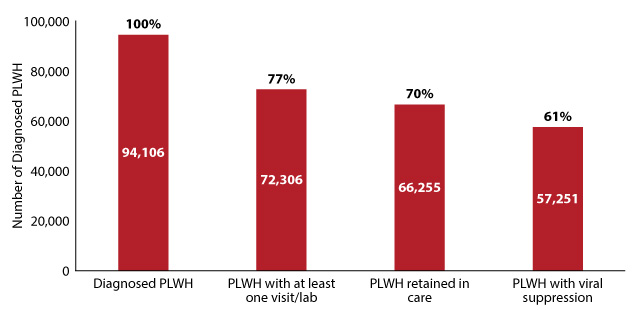Epi Profile Section 11 – HIV Treatment Cascade
The HIV Treatment Cascade is a visual representation of the continuum of care for Texans living with diagnosed HIV, as shown in Figure 23. The bars represent the steps between HIV diagnosis and the goal of viral load suppression. PLWH with suppressed viral load have better health and cannot transmit HIV through sex.
In 2018, almost 4 out of 5 Texans with a diagnosed HIV infection had evidence of care, 70% were retained in continuous care, and 61% had a suppressed viral load. Out of those with any care, almost 8 in 10 had a suppressed viral load.
We can also put the cascade results in terms of Achieving Together measures. We estimate that around 70% of Texans diagnosed with HIV were on treatment/retained in care, and around 86% of people on treatment had a suppressed viral load. The goal for both measures is 90%.
Figure 23: Texas HIV Treatment Cascade for 2018

Data for Figure 23
PLWH with at least one visit/lab – This bar includes all diagnosed PLWH who had at least one episode of HIV care in 2018. Evidence of an episode of care includes records showing an outpatient medical visit; a filled prescription for antiretroviral therapy (ART) drugs; a viral load test result; or a CD4 test result.
PLWH retained in care – This bar includes all diagnosed PLWH who had at least two episodes of care that were at least three months apart. It also includes PLWH who had a suppressed viral load as of the end of 2018 regardless of their patterns of care.
PLWH with viral suppression – This bar includes all diagnosed PLWH whose last viral load test value of 2018 was <200 copies/mL.
Texas HIV Epidemiologic Profile
